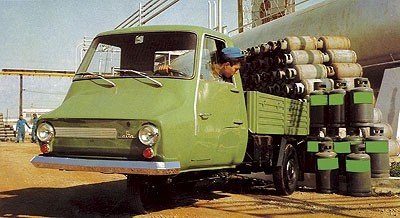In the bustling industrial landscape of 1967 Greece, a remarkable vehicle emerged from the workshops of Alta (Alexandra Tangalis) A.E. in Elefsina. The Alta A700, a three-wheeled commercial vehicle, represented a bold step forward in the country’s automotive industry, combining practical design with reliable German engineering.
The story of the A700 isn’t just about transportation—it’s about a pivotal moment in Greek industrial history. As European automotive giants dominated the continental market, Alta dared to carve its own niche with a unique approach to commercial mobility.
The Birth of a Greek Legend
The late 1960s marked a transformative period for European commercial vehicles. While major manufacturers focused on conventional four-wheeled designs, Alta took a different path. The A700 emerged from a vision to create a vehicle that could navigate Greece’s narrow urban streets while maintaining substantial cargo capacity.
Historical Reference!
Alta's decision to develop the A700 came at a time when Greece was experiencing significant industrial growth, with small businesses desperately needing efficient transportation solutions.
“The A700 revolutionized our delivery business,” recalls Andreas Papadopoulos, a retired Athens-based merchant. “Its maneuverability in tight spaces and reliable performance made it indispensable for our daily operations.”
The vehicle’s development involved careful consideration of local market needs and infrastructure limitations. Alta’s engineers focused on creating a balanced design that would prove both practical and economical.
Engineering Marvel: The BMW Heart
At the core of the A700’s success lay a masterful integration of German engineering. The decision to utilize BMW’s proven two-cylinder engine from the 700 series wasn’t merely a convenience—it was a strategic choice that would define the vehicle’s character.
The 35-horsepower powerplant offered an ideal balance of performance and efficiency. While modest by today’s standards, this output perfectly matched the vehicle’s intended use case, providing enough thrust to handle the 800kg payload while maintaining reasonable fuel economy.
Consider these key engineering achievements:
- optimized power-to-weight ratio for urban delivery operations;
- refined transmission system adapted for frequent stops;
- enhanced cooling system designed for Mediterranean climate;
- reinforced chassis structure supporting the unique three-wheel configuration;
- specialized brake system ensuring stability under varied load conditions.
The integration of these elements created a remarkably reliable commercial vehicle.
Fact!
The A700's engine shared DNA with the BMW 700 sport coupe, which had proven its reliability in demanding European racing circuits throughout the early 1960s.
Design Philosophy and Practicality
The A700’s three-wheeled configuration wasn’t just a design choice—it was a practical solution to real-world challenges. The layout offered exceptional maneuverability in confined spaces while maintaining stability under load.
“From an engineering perspective, the A700’s design was remarkably forward-thinking,” states Dr. Maria Stavrou, automotive historian at the University of Athens. “The weight distribution and load capacity calculations showed sophisticated understanding of commercial vehicle dynamics.”
Alta’s engineers paid particular attention to the cargo area design, ensuring easy loading and unloading while maintaining vehicle balance. The two-door cabin provided easy access while keeping production costs reasonable.
The practical benefits became evident in daily use. Small business owners particularly appreciated the vehicle’s tight turning radius and ease of parking, features that proved invaluable in Greece’s historic city centers.
Cultural Impact and Legacy
Beyond its commercial success, the A700 embedded itself in Greek cultural identity. Its appearance in the 1977 film “Griechische Feigen” immortalized its place in popular culture, while its widespread use transformed it into a symbol of Greek entrepreneurial spirit.
Info!
The A700's production run from 1967 to 1978 coincided with a significant period of growth in Greek small businesses, helping facilitate the expansion of local commerce.
The vehicle’s influence extended beyond its primary role as a commercial transport. It became a testament to Greece’s capability to produce innovative automotive solutions, inspiring a generation of engineers and entrepreneurs.
Throughout its 11-year production run, the A700 maintained its reputation for reliability and practicality. Its presence on Greek streets represented more than just a means of transport—it symbolized the nation’s industrial ambition and technical capability.
A Legacy of Innovation
The Alta A700 stands as a remarkable example of successful adaptation to local needs while maintaining international engineering standards. Its combination of German powerplant reliability and Greek design ingenuity created a unique vehicle that served its market exceptionally well.
Today, surviving examples of the A700 are cherished by collectors and historians alike, representing a fascinating chapter in automotive history where local innovation met global engineering excellence.
| Advantages | Limitations |
|---|---|
| Exceptional maneuverability in urban environments | Limited top speed compared to conventional trucks |
| Proven BMW engine reliability | Three-wheel design required adaptation period for drivers |
| Substantial 800kg payload capacity | Production limited primarily to Greek market |
| Low maintenance requirements | Weather protection less comprehensive than four-wheeled alternatives |
| Excellent fuel efficiency | Spare parts availability decreased after production ended |
| Simple, robust construction | Limited long-distance comfort |
| Cost-effective operation | Storage space constraints compared to larger vehicles |
The Alta A700 remains a testament to the potential of focused engineering solutions addressing specific market needs. While its production numbers may not rival those of major manufacturers, its impact on Greek commercial transportation and industrial development is undeniable. The vehicle’s legacy continues to inspire discussions about practical innovation in automotive design.

